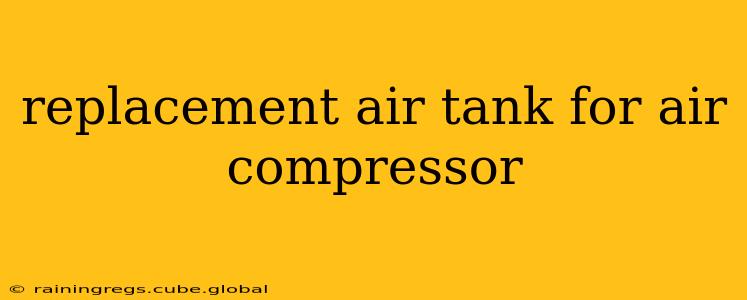Choosing the right replacement air tank for your air compressor is crucial for safety and optimal performance. A poorly chosen tank can lead to inefficient operation, potential hazards, and even damage to your compressor. This guide will walk you through the process, answering common questions and helping you find the perfect fit.
What Size Air Tank Do I Need?
This is often the first question people ask. The ideal tank size depends heavily on your air compressor's application. A larger tank offers several advantages:
- Longer run time: More compressed air means less frequent cycling of the compressor, extending its lifespan and reducing wear and tear. This is especially important for demanding tasks requiring sustained air pressure.
- Smoother operation: A larger tank helps to regulate air pressure, preventing pressure drops during use and leading to more consistent performance. This is particularly beneficial for tools sensitive to pressure fluctuations.
- Reduced compressor cycling: Less frequent on/off cycles mean less noise and energy consumption.
However, larger tanks also occupy more space and are generally more expensive. Consider your typical workload. If you use your air compressor for infrequent, light tasks, a smaller tank might suffice. For heavy-duty applications like spray painting or operating pneumatic tools for extended periods, a larger tank is strongly recommended. Check your compressor's manual for recommended tank sizes or consult the manufacturer directly.
What are the Common Air Tank Materials?
Air compressor tanks are primarily made from steel or aluminum. Each material offers distinct advantages and disadvantages:
- Steel: Steel tanks are durable, robust, and generally more affordable. They can withstand high pressures and are a popular choice for most applications.
- Aluminum: Aluminum tanks are lighter than steel tanks, making them easier to move and transport. They are also less prone to rust. However, they are typically more expensive and might not be as strong as steel tanks under extremely high pressure.
The material of your existing tank is a strong indicator of what type of replacement you should look for.
How Do I Choose the Right Pressure Rating?
The pressure rating (usually expressed in PSI or bar) is a critical factor. Never use a tank with a lower pressure rating than your compressor. Using a tank with a lower pressure rating is extremely dangerous and could result in catastrophic tank failure. Always choose a replacement tank with a pressure rating equal to or greater than the original tank. This information is clearly marked on the tank itself.
What about Tank Connections and Fittings?
The tank's connection points are equally important. Ensure that the replacement tank uses the same type and size of fittings as your original tank. Incorrect fittings can lead to leaks, and improperly sized connections can damage the tank or compressor. Double-check your existing tank and compressor to ensure compatibility.
What are the safety precautions when replacing my air tank?
Replacing an air tank is a potentially hazardous task. Always follow these safety precautions:
- Drain the tank completely: Before removing the old tank, ensure all compressed air has been released.
- Wear appropriate safety gear: Use safety glasses and gloves to protect yourself from potential injury.
- Consult your owner's manual: Review the instructions carefully to understand the specific procedures for your air compressor model.
- Professional installation (if needed): If you're uncomfortable performing the replacement yourself, consult a qualified technician. Safety should always be the top priority.
By carefully considering these factors – size, material, pressure rating, and connections – you can confidently select the perfect replacement air tank for your air compressor, ensuring safe and efficient operation for years to come. Remember to always prioritize safety and consult your compressor's manual for specific recommendations.
